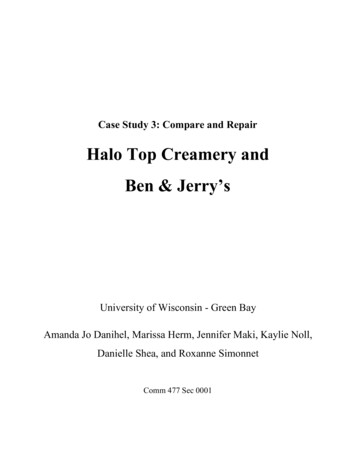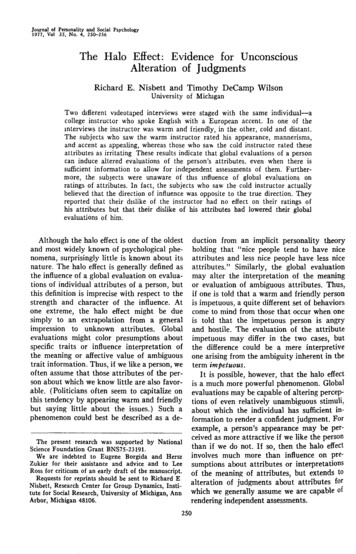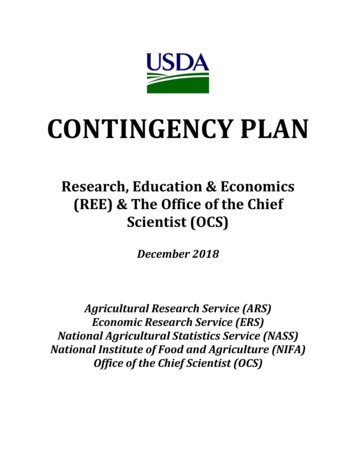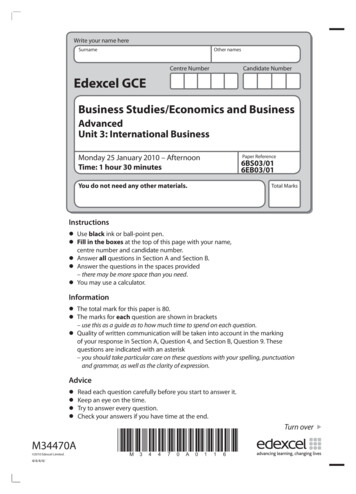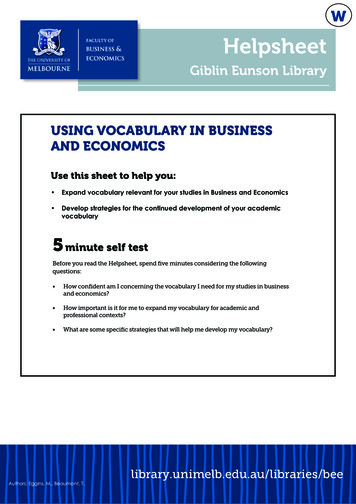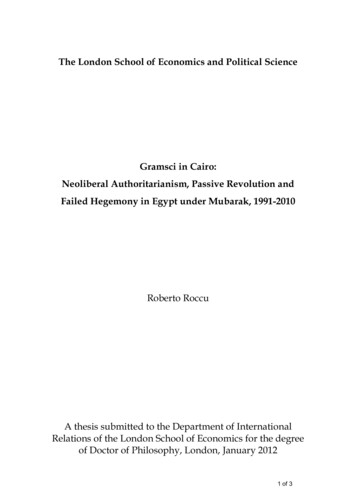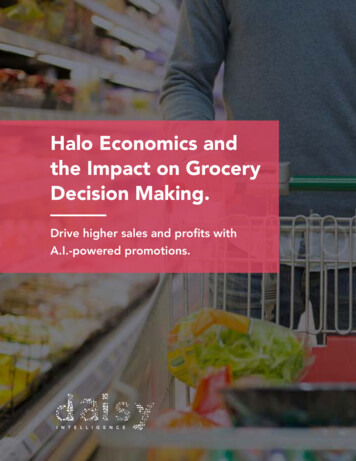
Transcription
Halo Economics andthe Impact on GroceryDecision Making.Drive higher sales and profits withA.I.-powered promotions.
Halo Economics and the Impact on Grocery Decision Making.Drive higher sales and profits with A.I.-powered promotions. 2019 Daisy Intelligence Corporation.
4INTRODUCTION7WHAT ARE HALO SALES?11IMPACT ON TOTAL STORESALES17FUTURE OF THE GROCERYBUSINESS18SKATE TO WHERE THE PUCK ISGOING, NOT WHERE IT IS 2019 Daisy Intelligence Corporation.3
1INTRODUCTIONThe 800-billion grocery business isIf every merchant achieves their categorydramatically changing.growth goals, the business, in theory, willreach its corporate and financial goals. ThisEstablished players such as Walmart,model has held true for decades, but it isAmazon, and Aldi, and online retailers arenow being tested amid volatile industryputting more pressure on prices.conditions.Not surprisingly, the need to establish aAt the core is a paradigm shift aroundcompetitive edge has never been morecategory management and the need toimportant.take a holistic approach rather than treatingcategories as economic silos to drive betterTo drive business, grocery retailers havecorporate sales and profits.heavily depended on promotions to capturethe spotlight.A key part of category managementoptimization is managing the complexMerchants are empowered to selectrelationships between products, otherwisepromotional products and prices. Many ofknown as category interactions.these choices are based on the followingfactors:But here’s the thing: while retailers recognize Vendor contribution; slotting fees tothere are category interactions as a resultfeature their products.of their decisions, it is difficult to quantify Historical analytics.the overall business impact. It is even more Last year’s performance; many merchantsproblematic to decide which items driveoften duplicate decisions made thelarger category interactions given there areprevious year.billions of potential combinations, which areimpossible for humans to calculate. 2019 Daisy Intelligence Corporation.4
The reality is that some promotional productcorporate sales and profits.decisions have a negative, neutral, or minimalimpact on total sales due to unseen cross-This is known as the “Halo Effect”, whichcategory interactions such as cannibalizationinvolves selecting the right promotionaland forward buying/pantry loading that canproducts to drive associated sales of highcancel out the promotional lift.margin items (if the halo items are not alsopromoted). When executed using bestIn this eBook, we will explore cross-categorypractices, the halo effect can increase totaloptimization and how it will change howsales by 5% and more than double netpromotions are planned to drive higherprofits. 2019 Daisy Intelligence Corporation.5
2019 Daisy Intelligence Corporation.6
2WHAT ARE HALO SALES?Consumers buy use cases, not products.product. Here are some examples based onThey purchase items, for example, to make adata from our customers:spaghetti dinner: ground beef, pasta, cheese, Tomatoes have strong halo sales becausetomatoes, and bread. All products have halothey are part of a huge number of usesales because they are part of use cases.cases and consumers tend to buy aSome items have multiple use cases, whilevariety of associated products such asitems such as water or chocolate bars are notcucumbers, salad dressing, and pepperspart of any use cases.that have high margins. Diapers, on the other hand, haveEvery product has halo sales. It can vary fromlow halo sales because there arenegative (taking into account forward buying)few associated products and a smalland almost nothing to more than 10:1 fornumber of use cases. Many consumersitems like produce, weekly low-cost productsbuy diapers when they are on sale butlike meat, and consumer staples.they are unlikely to buy high marginassociated products other than itemsThe halo is driven by the use case for asuch as wipes and lotion.Every product belongs to a different number ofuse cases and products require other productsto complete the use case. Diapers have fewuse cases, while produce has hundreds orthousands of use cases. The higher the numberof use cases, the higher the associated sales. 2019 Daisy Intelligence Corporation.7
There are billions of potential productproduct’s sales and its halo is a constant ratio,combinations so it is beyond humanwhether the product is promoted or not. Thecapability for grocery retailers to create theuse case for a pasta dinner does not changeideal product mix that maximizes profits andbecause ground beef is on sale.sales.In simple terms, it means that if you sell moreThe key to success is making the invisiblehamburger buns each time that hamburger is– the incremental halo effect – visible sosold unpromoted; then whenever hamburgergrocery retailers can effectively manage it tois promoted, you will sell an incremental anddrive better financial results.proportional amount of hamburger buns. Thehalo relationship remains intact.An important fact: the relationship between aThe graphs show several years of hazelnut cocoa sandwich spread and beer sales. Despite the pricechanges, the associated sales are perfectly proportional and constant. Many people shop with a usecase. When they buy sandwich spread, for example, they also purchase things to put it on or to bakewith. The same use case holds true for beer.These charts represent five years of weekly data points. The vertical line represents sales of promoted itemswhile the horizontal line represents halo sales.The slope of the first chart (sandwich spread) is steeper than the slope of the second chart (beer). In the firstchart, the halo (sales of associated products) for sandwich spread is 20:1. For beer, the halo is only 2:1. 2019 Daisy Intelligence Corporation.8
When looking at the success ofpromotional activity, product salescan’t be viewed in isolation.Daisy has a client, for example, that regularlyrequired.promoted wine.By promoting affinity products withIn a given week, sales of these productshigh halos, grocery retailers can get anincreased by 53,000, which indicated to theincremental lift in sales of associatedretailer that the promotion was a success.products at a higher margin than theAssociated sales, however, were onlypromoted product. if they don’t also 50,000, which meant that most customerspromote the halo products. This requiressimply bought the wines on sale. A 1:1 ratiocross-category cooperation across hundredsof associated sales to product.of thousands of consumer use cases on amassive scale beyond what human merchantsAfter the grocery retailer used Daisy’sand category managers can effectivelytechnology to analyze its transactions andcontemplate and deliver.identify products with high halo sales, wesuggested it promote chocolate ratherTiming and frequency are also key factorsthan alcohol in a valuable ad block. Whenin product promotion and every productpromoted, chocolate sells the same amounthas its own cadence. Promoting a productas beer but it has a 1:16 halo ratio, whichtoo often means giving up margin while notdelivers 800,000 in incremental sales.promoting frequently enough leads to missedopportunities to drive sales.The data shows that chocolate has manymore use cases than wine. This example wasBut again, it is humanly impossible toaround a holiday so chocolate also enjoyedunderstand the different buying patterns;a seasonal effect around baking, gifts, etc.baselines, promotional lifts, recovery periodsMeanwhile, the use case for wine is simplyand elasticity (promotional and price) for tensbuying wine because here no other productsof thousands of products. 2019 Daisy Intelligence Corporation.9
2019 Daisy Intelligence Corporation.10
3IMPACT ON TOTAL STORE SALESOn average, 25% to 35% of a grocerystore approach to promotional product mixretailer’s products are typically promotedoptimization and pricing – impacting the net(otherwise known as the core range or coreP&L.promotional products).Instead of managing categories in silos,In working with clients around the world,grocery retailers can leverage halo sales toDaisy has discovered that promoted productsoptimize their product mixes. It’s about thetypically experience a 15% to 25% lift in saleseconomic value of the total basket ratherover their baseline. The unpromoted halothan individual products.items will also see a comparable 15% to 25%sales lift over their baseline because the ratioThis economic visibility represents a majorof the promoted item to its halo is constant.evolution in how grocery retailers areIf they aren’t promoted, the halo items,operating and, as a result, it has a significantwhich have higher profit margins, can includeimpact on their promotional activities.products not only in the core range but withinthe whole store.By embracing a cross-category philosophy,a grocery retailer’s promotional activities willIf grocery retailers can double incrementalevolve. And when it comes to measuring thehalo sales (after netting out cannibalizationimpact, silos are being eliminated. It is nowand forward buying) with promoted productsabout the contribution to the overall businessby choosing an optimized product mix toversus a specific category.promote, our data shows it will drive a 5% orgreater impact on total store sales.A cross-category approach provides groceryretailers with a powerful advantage and aAnother thing that makes the focus on halonew economic operating model. And, notsales so attractive is it emboldens grocerysurprisingly, there will be other financialretailers to take a cross-category, totalimpacts. 2019 Daisy Intelligence Corporation.11
Some grocery clients, for example, haveembrace A.I. and data intelligence to capturemoved to new compensation models to moremore halo-driven margins.closely align with the contribution to overallcorporate sales and profits.The invisible has become visible. Giventhe financial impact of halo sales, leadingInstead of rewarding managers andgrocery retailers are adopting a new strategymerchandisers for only the success of theirto promotional product optimization andindividual categories, compensation is basedpricing.on the category and merchandising team’scontribution to the overall business.Armed with semi-annual or annual subcategory promotion optimization plans,When everyone’s interests are aligned,grocery retailers are actively steering CPGcategory managers and merchants workmanufacturers to finance promotionaldifferently. There is more collaboration andproducts with higher halo sales. (Note: CPGstrategic thinking about selecting high halocompanies can still use the traditional “pay toproducts that deliver excellent financialplay” model to acquire advertising space forresults.products with low halo sales because thereare consumers for all products.)At the same time, category managers andmerchants also understand there are productsThis lets the voice of customer play a morethat should not be promoted as frequentlyinfluential role in the promotional planbecause they don’t drive associated productsrather than simply relying on last year’s plan.with higher margins.Leveraging transaction log data is the singlemost customer-centric decision that retailersA holistic economic model rather than oneare making and, as important, it is dispellingfocused on particular categories or productsthe old adage “that’s the way we’ve alwaysmakes the new economic model even moredone it”. This mantra will not propel yourinteresting and disruptive.business forward in the new economic reality.With Amazon and other new entrants puttingpressure on pricing, now is the time to 2019 Daisy Intelligence Corporation.12
Optimizing profits, sales,and shareholder valueallows first movers topressure competitorsas opposed to havingto react and play catchup. Taking a holisticapproach to productpromotion and pricingmakes the new economicmodel more lucrativeand disruptive. 2019 Daisy Intelligence Corporation.13
THE HALO AND THE NET PROMOTIONALEFFECTThe halo reflects the sales impact generated by a promoted product. The bigger the halo, the highersales of higher margin associated products. The halo is mathematically summarized by Daisy’s NetPromotional Effect, or NPE.The two charts below represent a retailer’s quarterly sales for Q1 2012 and Q1 2014. Over two years,we nearly doubled the halo and NPE. In that period, we improved their NPE to 671.3-million from 382.2-million.By focusing on selecting products with a higher halo, the impact was nearly 300-million in NPE,which goes straight to the bottom line. The 300-million represents 5% of total sales.Q1 2012.Q1 2014. 2019 Daisy Intelligence Corporation.14
2019 Daisy Intelligence Corporation.15
2019 Daisy Intelligence Corporation.16
4FUTURE OF THE GROCERY BUSINESSSo what does this evolution mean for theway to do business. But this doesn’t meangrocery business?that you should never promote some lowerperforming categories.With plus and minus category interactionsfactored in, category measurement andAdvertising and marketing still need tofinancial success become defined by totaleducate the consumer about the depth andstore contribution, and decisions are madebreadth of a retailer’s assortment. On thein the best interests of the company, not theweeks that a retailer decides to educatecategory or product.consumers, financial performance can bemaintained by focusing on exceptionallyAnother important consideration aroundhigh performing categories to balance thethe halo is pricing. Vendors who price theireducational/marketing ads that may be lowerproducts without considering the finalperforming.promotional product mix are not accountingfor the category interaction effects. Instead,Cross-category merchandising providesthey are treating their products as standaloneretailers with an opportunity to optimizeentities. Daisy prices the product mix as afinancial results while continuing to educateseparate step because “the mix matters”. Incustomers. And, of course, higher salesother words, it’s all about driving halo sales.driven by promotional optimization will begood for the company, category managers,At the end of the day, a cross-categoryand merchandisers.approach that embraces product andpricing optimization is a more successful 2019 Daisy Intelligence Corporation.17
5SKATE TO WHERE THE PUCK ISGOING, NOT WHERE IT ISThe grocery industry’s economics areand optimize it is critical.changing. and changing fast.Daisy’s technology makes the invisible visible.Evidence shows that grocery retailers whounderstand and embrace the impact of haloA customer recently said that we deliversales are seeing significantly higher sales and“an entirely new and revolutionized” wayprofits; we’re talking a 5% increase in toplineto optimize promotions, which representsrevenue and, in some cases, more than 100%a quantum leap in how his company doeshigher profits!business.While recognizing the value of halo sales as aAre you ready to embrace the halo as part ofgame-changer is important, the ability to seethe new economics of grocery? 2019 Daisy Intelligence Corporation.18
About Daisy Intelligence.Daisy Intelligence delivers A.I.-poweredFor grocery retailers, Daisy can drive 100%decisions that help grocery retailers andhigher profits and 5% higher total sales byinsurance companies make higher profitsoptimizing prices, product selection, andevery year. And we can prove it.demand forecasting.Combining math and science, we analyzeWe can help insurance companies become100% of your data, tackling the time-significantly more profitable by quickly andconsuming and complex work to extractaccurately identifying fraudulent activity,valuable intelligence that accelerates thehelping them reduce claims payments bygrowth of your business.millions of dollars.Sees what others don’t. 2019 Daisy Intelligence Corporation.19
0 Steeles Avenue West,Suite 240, VaughanOntario Canada L4K 5X6
The 800-billion grocery business is dramatically changing. Established players such as Walmart, Amazon, and Aldi, and online retailers are . embrace A.I. and data intelligence to capture more halo-driven margins. The invisible has become visible. Given the

